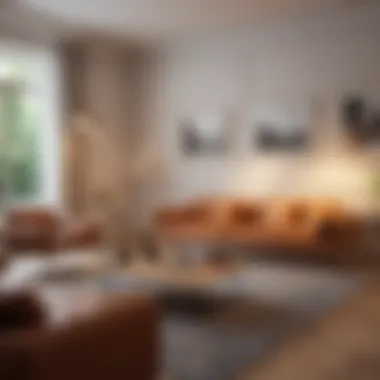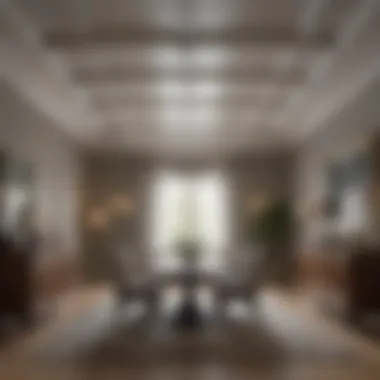Finding the Ideal Height for Picture Hanging


Intro
Hanging pictures may seem like a simple task, but the height at which they sit can have a profound impact on the overall aesthetic of a room. Much like the proper seasoning can make or break a dish, the positioning of your artwork can dramatically influence the feeling of a space. Homeowners often grapple with questions around picture placement. Should they be hung higher to fit grand ceilings or lower for cozy corners? This guide dives into the intricate dance between artwork and architecture, exploring essential principles for determining that optimal height.
Home Design Inspiration
When it comes to interior decor, imagination often dances hand-in-hand with functionality. Here, we will break down the different architectural styles and recent decor trends that can inspire how you showcase your picture gallery.
Architectural Styles
From contemporary to Victorian, each architectural style offers a different canvas for picture hanging. Here are a few insights:
- Modern Design: In spaces with open concepts and high ceilings, it’s common to hang art at eye level, or about 57 to 60 inches from the floor, creating a focal point that draws the eye upward.
- Traditional Homes: Here, crown moldings or wainscoting add layers and depth. Art can be hung lower, sometimes just above furniture, allowing it to coexist with architectural features.
- Industrial Spaces: For loft-style homes with raw materials, large-scale art pieces can be hung higher, catching light through expansive windows and complementing elements like exposed beams and brick walls.
Innovative Decor Trends
In recent years, the growing popularity of gallery walls has transformed how we think about picture placement. Instead of singular pieces, collections of various sizes create a dynamic visual experience. Here are some trends to consider:
- Eclectic Mix: Combine different frames and art styles for a lively impact. Try to keep a cohesive color palette to tie the mix together.
- Vertical Arrangement: Especially effective for narrow spaces like hallways, this method optimizes available wall space while attracting the viewer’s eye upward.
- Symmetry: For a polished look, symmetrical arrangements can induce a sense of order and calmness, especially in more structured environments.
"Attempting to find the perfect height for your beloved photographs can sometimes feel like chasing your tail. But understanding your space is half the battle won."
Ending
Understanding the nuances behind picture placement is paramount for enhancing a room’s appeal. By considering architectural characteristics, current decor trends, and the functional intention of a space, you’ll create a visually engaging display that resonates with both residents and guests alike. Keep tinkering with arrangements until you find that sweet spot; after all, art is meant to be appreciated at every glance.
Understanding the Importance of Picture Height
Hanging pictures at the right height isn’t just about aesthetics; it's a critical element in how spaces are perceived and experienced. The height at which art is displayed can significantly influence the ambiance of a room and the viewer’s emotional connection to the artwork. Beyond mere decoration, proper picture height fosters a sense of visual unity and balance in your living environment. When thoughtfully done, art placement promotes a seamless integration of design elements.
A well-placed picture draws the eye naturally and enhances the overall flow of the space. For instance, if you place a gorgeous landscape painting too high, it may become lost against the wall, failing to resonate with visitors. Conversely, hanging it too low can create an uninviting barrier, making the piece feel cramped. Achieving the sweet spot optimizes your enjoyment of the art and the design of your home.
Moreover, the interaction between artwork and furniture cannot be ignored. For instance, a large piece of art positioned above a sophisticated sofa or a cozy side table can pull the entire arrangement together, adding depth and coherence. By considering the height of both the artwork and the surrounding furniture, you can create a richer narrative in your space, allowing the art to breathe and express itself.
"Great art requires a stage—make sure it shines where it should be seen."
Finally, art placement can also reflect personal style and adapt to changing design trends. Understanding where and why certain heights work best allows homeowners to cultivate a space that feels both contemporary and timeless. This knowledge not only assists you when decorating your current space but is a valuable tool for future projects. Knowing the basics of picture height guarantees that whether you’re showcasing a family portrait or an abstract piece, you are doing so in the best possible light.
The Role of Visual Harmony in Interior Design
Visual harmony in interior design is about achieving a balance among various components within a space. Picture height plays a critical role in this harmonious arrangement. By aligning artwork with the overall design theme—be it minimalist, eclectic or classic—you can create a serene environment that feels inviting and cohesive. For instance, in a room filled with neutral tones, a striking, larger-than-life piece can serve as a focal point, pulling the elements together as long as it is strategically placed at the right height.
Keeping pictures at eye level or slightly above is often recommended to ensure that viewers can connect easily with the art. This connection fosters a relationship where each piece can resonate with its observer, making the overall space feel warm and welcoming. Additionally, when art is hung in accordance with visual harmony, it draws attention without overwhelming the space, inviting a sense of balance and tranquility.
Psychological Impacts of Art Placement
Art placement isn’t simply about where to hang a frame; it’s also about how that placement affects human psychology. Research indicates that artwork can evoke emotions, inspire creativity, and even cause stress reduction when properly displayed. When pictures are hung at optimal heights, they relate better to the viewer’s line of sight and can have a profound impact on mood and perception.
For example, artwork positioned at eye level can lead to a more inviting atmosphere, making visitors feel comfortable and engaged. In contrast, pieces displayed too high can create feelings of exclusion or disconnection. More than just a visual consideration, the psychology of picture hanging brings to light how environment influences emotions and cognitive responses.
Creating an emotional bond through art is often the essence of why we choose to adorn our walls. When you hang pictures considering their height, you are actively enhancing this bond, enabling a deeper interaction with the artwork and elevating the overall sense of place within the home.
Common Guidelines for Hanging Pictures
When it comes to displaying artwork, a few guiding principles can make all the difference. Common guidelines for hanging pictures serve not just as a set of rules, but as a framework that can elevate the entire aesthetic of a room. Think of it as the difference between throwing paint on a canvas and creating a masterwork; structure gives clarity and purpose to what could otherwise be chaotic.
By adhering to these guidelines, you ensure that your art doesn't just sit on the wall but dances within the space, drawing the eye and creating a narrative. It’s essential to consider elements such as the balance between vertical and horizontal pieces, the relationship to furniture, and, significantly, the optimal height for each work. This careful consideration leads to a display that feels both intentional and inviting.
The Center Point Rule
One solid guideline that many interior designers stand by is the Center Point Rule. This concept posits that the focal point of any artwork should be approximately 57 to 60 inches from the floor. Why this specific measurement? It’s said that this height aligns with the average human eye level, ensuring that the artwork is neither too high, making it strenuous to admire, nor too low, which can diminish its impact.
In practical terms, think about a well-articulated conversation; if the pieces of art you place on the wall don't sit within that conversational range, there’s a good chance they will be overlooked.
Benefits of the Center Point Rule:
- Creates Cohesion: When multiple pieces are hung at this height, they create a unified look that can draw a room together.
- Enhances Viewing Comfort: Art hung at eye level is more easily viewed, allowing for appreciation of details without strain.
- Establishes Balance: Maintaining a similar height across pieces can prevent a sense of clutter and confusion.
Eye Level Considerations
After establishing the center point rule, understanding eye level considerations can refine your method further. Everyone has their own sense of what feels natural, and, interestingly, this can vary based on the individual's average height, how the room is used, and the type of furniture present. For example, in a space designed for conversation, artworks may be positioned slightly lower to facilitate interaction.
Moreover, in a dining area, where people typically sit, you might want to hang art relative to seated eye levels, ensuring that the display complements rather than disrupts the flow of the room.


"Art is not a thing; it is a way."
Adjusting for Different Room Types
Each room in a home has its unique characteristics and functions, so adjusting your picture hanging strategies accordingly is vital.
- Living Rooms: Larger artworks can anchor a space, while smaller pieces can fill in gaps around furniture. Consider symmetrically arranging pieces over a sofa or a console table to achieve balance.
- Hallways: A long, narrow hallway can benefit from staggered placements of art; this invites the viewer to engage as they walk through. Rather than a single point of focus, a series of smaller pieces can create visual interest.
- Bedrooms: In more personal spaces like bedrooms, softer colors and calm imagery can be a better fit. Think about the scale of the bed and adjust accordingly, ensuring art above the headboard feels integrated with the overall tranquility of the room.
Maintaining awareness of the room’s purpose and dynamics allows for a more effective art placement, enhancing the overall atmosphere and user experience. A thoughtfully arranged piece can transform a simple wall into a conversation starter or a soothing visual escape.
Factors Influencing Picture-Hanging Height
Deciding on the right height to hang pictures involves more than just guesswork. There are several key factors that play crucial roles in determining the optimal point for display. Understanding these factors not only enhances the aesthetic value of a room but also contributes to the functionality of the space. Hence, let's delve into the specific elements that should be taken into account, including ceiling heights, furniture arrangement, and the overall style or theme of the home.
Ceiling Heights and Room Dimensions
When it comes to hanging art, ceiling height is one of the first considerations you should evaluate. In rooms with tall ceilings, it's tempting to display larger pieces of art much higher, thinking it creates drama. But this might not always be the best approach. A taller room can actually absorb the essence of the artwork if it is placed too high, making it feel disconnected from the rest of the space. The key is to maintain a sense of balance.
A good rule of thumb is to hang artwork where the center of the frame is about 57 inches off the ground. However, in cases where ceilings soar, you might want to go a little higher—up to 65 inches. This way, you improve visibility without losing the intimacy that a piece can provide.
Moreover, the dimensions of the room itself are significant. In smaller rooms, clustering smaller pieces at eye level can create a gallery-like feel and makes the space feel more welcoming instead of overwhelming.
Furniture Arrangement and Proximity
The placement of furniture should not be overlooked in the equation of hanging height. A picture hung above a sofa or console table needs to reflect the arrangement of the items below it. If you hang a picture too high, it can feel out of place. As a general guideline, the bottom of the artwork should be around 6 to 12 inches above the back of the furniture.
This not only creates a cohesive look but also ensures that the artwork is within reach visually, allowing it to contribute to the overall atmosphere of the room. You take into account how people will interact with the space. For instance, in a seating arrangement, looks can be deceiving—what seems like the right height from standing may not resonate when you're seated.
Style of the Home and Decor Theme
Your home's decor style also plays a significant role in determining the picture-hanging height. If you have a contemporary home with clean lines and minimal furniture, art can be hung higher with fewer elements competing for attention. Conversely, in more eclectic or traditional spaces, lower hanging art may work better to blend seamlessly with an array of textures and furnishings present, cultivating an inviting atmosphere.
Consider the aesthetic of the room as well. Modern environments may benefit from more asymmetrical arrangements higher up, while classic styles might call for symmetry and gradual transitions in height. Additionally, if your decor includes large sculptures or additional design elements that draw the eye, it's wise that artwork complements those features without overpowering them.
"Art is a reflection of the room, not an entity to be displayed in isolation".
Ultimately, the goal should be to create a space where all elements harmonize—neither fighting for contention nor fading into the background. Thoughtfulness in these aspects will ensure that the artwork enhances the ambiance of the space while remaining aesthetically pleasing.
Practical Steps to Measure Hanging Height
Using a Measurement Tape Effectively
When it comes to hanging art, a measurement tape isn’t just a tool; it’s your best buddy in getting the height just right. First, grab your tape measure, and be sure to choose one that’s flexible enough to hug the wall if needed. Here's a couple of tips:
- Always start measuring from the floor up. Hanging pictures about sixty inches from the ground to the center of the frame is a reliable rule of thumb, but adjustments might be necessary based on your space.
- Take into account the ceiling height in the room. For instance, rooms with higher ceilings can allow for slightly elevated placements, while lower ceilings should bring art closer to eye level to avoid a cramped feel.
Focus on keeping the tape straight and avoid pulling too tight. You want the measurement to reflect the distance accurately without being skewed by too much tension in the tape. It can also be helpful to make note of your findings on a notepad for easy reference. If the room has furniture or other features that alter view, consider those in your calculations.
Marking the Wall: Techniques and Tools
Once you’ve gotten your measurements down, the next critical step is to mark the wall. This preliminary step can save you from a lot of effort and potential mishaps. Here are some techniques to properly mark without damaging your wall:
- Pencil Markings: A simple pencil is great for this task. Just make gentle marks where you’ll need to position the hardware. Pencil is easy to erase or paint over if you miscalculate.
- Post-it Notes: If you’re feeling a bit more organized, using sticky notes can serve as a temporary reminder of your chosen height and can easily be moved without leaving marks.
- Level Tool: Once you’ve indicated the points, using a level tool is crucial for ensuring the artwork hangs straight. A wonky picture can be an eyesore and distract from the intended beauty of your decor.
"The process of preparing your wall is as vital as choosing the artwork itself. A little thought and care in measurement and marking can elevate the aesthetic value of any space tremendously."
So, make sure you've got your tools prepared before you even think about putting a nail in the wall. Taking these practical steps ensures that your artwork isn’t just hung, but that it shines in its place.
Creating a Gallery Wall: A Unique Approach
Creating a gallery wall can be one of the most rewarding and creative ways to display art in your home. This unique approach adds a personal touch to your space and allows for the expression of your style and sentiments. Instead of having a single focal point, a gallery wall thrives on the beauty of variety – a collection that speaks volumes without uttering a word. More than just random pieces tossed together, it requires a thoughtful curation that can speak to visitors and, more importantly, resonate with you.
When you consider the factors involved in making a successful gallery wall, there’s a lot to unpack. First, the design of a cohesive look is fundamental. Think about harmonizing colors, styles, and themes. You might want to create a specific mood or channel a particular era by aligning framed photos or artworks that evoke that sentiment. Not every piece has to be framed alike, but they should still tell a story when put together.
Also, the visual flow is significant. A mismatch in frame styles or colors can throw the whole arrangement off-kilter.
Designing a Cohesive Look
The key to a harmonious gallery wall is ensuring that all elements feel interconnected. When designing a cohesive look, start by choosing a central theme or color palette. For example, if your wall features vintage photographs, perhaps consider using frames that have a similar style – significantly, rustic wooden frames paired with sepia-toned images can evoke nostalgia effectively. Alternatively, you might opt for modern art prints that complement contemporary decor with sleek, black frames.
Below are a few tips for achieving that cohesive look:


- Choose a Color Palette: Pick colors that complement each other. You can go with neutrals, or if you want a pop of color, select one or two accent colors that will tie the pieces together.
- Frame Consistency: Maintain consistency in frame width and depth. A great way to balance things out is to mix types within those parameters; for instance, a mix of metal and wood frames can add an appealing visual tension while remaining cohesive.
- Art Styles: Combine styles but within reason - abstract with realistic works can coexist if you plan their placements well, balancing them across the wall.
Spacing and Alignment Techniques
The spacing and alignment of your gallery wall is just as significant as the pieces you choose to hang. If you don’t pay attention to these aspects, even the best designs can fall flat. A well-arranged gallery wall should feel intentional, not like a haphazard collection stuck to the wall.
Here are some effective spacing and alignment techniques:
- Equal Spacing: Aim for equal distance between pieces. A commonly suggested distance is around 2 to 6 inches, but your specific wall can dictate the best choice. Smaller frames may fit better with tighter spacing, while larger pieces may require more room to breathe.
- Grid Pattern: For a structured appearance, employing a grid formation gives an orderly feel to the display. Arguably, this suits more minimalistic decor styles or modern homes well.
- Eye Level Alignment: Arrange the focal pieces at eye level, which is generally considered to be around 57 to 60 inches from the floor. This aligns with the natural line of sight and ensures that the viewer can engage with your art effortlessly.
Creating a gallery wall isn't just about displaying art; it’s an opportunity for storytelling and expressing individuality through curation. By thoughtfully considering how you craft that cohesive look and carefully planning spacing and alignment techniques, you can elevate your interior while instilling a sense of warmth and creativity into your surroundings.
Considerations for Different Types of Art
When it comes to hanging art in your home, it's not just about where to put it; the type of art plays a significant role in determining its optimal height. Each style of art has unique characteristics, and understanding how these interact with your space will enhance the overall viewing experience. From framed pictures to canvases or even sculptures, there are important considerations that can dictate how high or low you should hang your art pieces.
By paying attention to the medium and form of the art, you’re not only ensuring that they’re displayed attractively but also maintaining their integrity and enhancing their impact within the room.
Framed Pictures vs Canvases
Framed pictures, generally with more intricate designs and details, often require careful placement to ensure that their beauty is fully appreciated. These pieces typically look best when hung at eye level, about 57 to 60 inches from the floor to the center of the frame. This standard is based on the average person’s line of sight, allowing viewers to appreciate the piece without craning their necks or bending too low.
On the other hand, canvases might offer a bit more versatility in height placement. Unlike framed pieces, canvases can exude a more casual vibe. When displayed, they can either hang at eye level or slightly higher, especially if they’re larger or part of a gallery arrangement. For instance, a large canvas can create a striking focal point when placed higher on a wall, drawing the eye upwards and giving the illusion of height in a room.
A couple of things to mull over when hanging framed pictures versus canvases include:
- The surrounding decor: Framed pictures may clash with minimalist styles, whereas canvases can complement them nicely.
- The content itself: If your art tells a story or conveys emotions, placement can amplify its message, inviting deeper reflection.
Two-Dimensional vs Three-Dimensional Works
The difference between two-dimensional and three-dimensional art pieces is yet another factor to reckon when deciding on height. Two-dimensional works, such as paintings or photographs, typically follow the glassy-eyed rule, raised about 57 to 60 inches as mentioned earlier.
However, practitioners of interior design often suggest a more dynamic approach for three-dimensional works, like sculptures or mixed-media pieces. These can create visual interest at various heights; they don’t have to adhere to the same placement rules as flat pieces due to their depth and tactile nature.
For example, a sculpture displayed on a pedestal might look better at a height that demands attention, while wall-mounted pieces could be set lower to engage viewers more directly. Additionally, consider factors such as lighting and surrounding furniture when placing three-dimensional art. A sculpture next to a tall couch might need to be set higher so it doesn’t get dwarfed.
In summary, the art type truly shapes your overall design strategy. Each beloved piece tells its own story—how you present it can either bring it to life or leave it in the shadows. Knowing the differences and considering these factors will undoubtedly elevate the ambiance of your space.
Alternative Methods of Display
When it comes to hanging pictures, there are more paths to creative expression than just the standard nail-in-the-wall approach. Exploring alternative methods of display can transform your art arrangement into an eye-catching exhibit. These methods not only provide flexibility in how artworks are showcased but also enable homeowners to express their personal flair, creating a space that genuinely resonates with their style. Let's delve into two particularly engaging approaches: using shelves for display and incorporating hooks and hangers.
Using Shelves for Display
Shelves offer a versatile framework for displaying art that allows for easy modification. Instead of committing to permanent placement, shelves provide the chance to mix and match at will. Here are some advantages to consider:
- Flexibility in Arrangement: Unlike traditional hanging where a hole is drilled and a picture is hung, shelves allow for quick adjustments.
- Layering of Art Types: You can display framed pictures, books, and small sculptures simultaneously, creating an engaging visual narrative.
- Convenience in Changing Decor: If you find yourself wanting an entirely new look, simply swapping out artwork on a shelf can instantaneously refresh your space.
To maximize the effectiveness of shelves in showcasing art, a few pointers could go a long way. Keeping varying heights can create visual dynamics, while ensuring the shelves are in harmony with existing furniture is vital as well. Aim to maintain balance; avoid overcrowding a single shelf while also letting negative space breathe.
Incorporating Hooks and Hangers
Hooks and hangers can bring a playful, organized vibe to your art display. They allow for artistic freedom, enabling a homeowner to create a look that feels both casual yet curated. Hooks are especially handy for uniquely shaped or heavier art pieces.
Key things to note with this method:
- Durability: Good-quality hooks can support a range of artwork weights, from lightweight canvas to heavier framed photos.
- Creative Freedom: Hooks break the mold of standard straight lines. There's an opportunity to display art at different heights or even on slants.
- Quick Changes: Similar to shelves, changing what’s hung can be achieved without much fuss, giving you the ability to keep your display feeling fresh.
When employing hooks, it’s vital to consider the spacing. Think about the size of the art pieces and the overall look you want to achieve. Spacing too close might make everything feel jumbled, yet spacing too far apart could make individual pieces feel isolated.
In summary, utilizing shelves and hooks doesn’t just innovate picture display methods; it's about fostering an atmosphere that reflects personal stories and aesthetics. These strategies emphasize flexibility and creativity, making the home a canvas of its own.
"Art enables us to find ourselves and lose ourselves at the same time."
- Thomas Merton
Exploring alternative methods opens a world of possibilities. By adopting these ideas, a homeowner can turn any wall into not just a decorative element, but a narrative reflecting their individual journey.
Cultural and Traditional Influences on Art Display


Understanding the various cultural and traditional influences on art display can significantly enhance one’s approach to hanging pictures. Art is a reflection of society, echoing its values, history, and even its conflicts. This section delves deeper into how specific cultural practices and traditions shape the way art is presented in different regions of the world. For anyone interested in home decor, an appreciation of these influences aids in creating a space that is both aesthetically pleasing and culturally resonant.
To begin with, establishing the right height for art pieces should not only be guided by structural considerations but also by cultural normativities surrounding visual storytelling. In many cultures, how art is hung is a representation of their connection to heritage and aesthetics. For example, in many Asian cultures, there’s a tradition of placing art lower on walls, allowing closer inspection and interaction. This contrasts with Western practices, which often emphasize elevation as a means of creating a sense of grandeur.
Global Variations in Art Placement
Art placement indeed varies widely around the globe, shaped by local traditions and aesthetic preferences. In Scandinavian countries, for example, minimalism reigns supreme. Art is often hung with considerable space around it, allowing for the design of clean lines and open spaces. This approach fosters a sense of tranquility, aligning with their philosophical understanding of ‘hygge,’ or coziness.
On the other hand, in places like Mexico, vibrant colors and motifs characterize their art scene. Artwork often fills every available space and may even extend beyond conventional hanging methods, such as incorporating it into furniture design or as part of outdoor spaces. This cultural context dictates not merely the height but the visual density and color saturation in displays.
- Key Variations to Note:
- Scandinavian Minimalism: Art hung with significant white space around it.
- Mexican Vibrancy: Art characterized by bold colors, frequently filling the space available.
This understanding of global variations fosters a deeper appreciation for diverse art forms and how they can be integrated into one’s own living space.
Historical Context of Art Display
Looking back at the historical context of art display provides a clearer picture of where modern practices originated. In ancient cultures, art was often created for specific societal functions or to honor deities.
For instance, in Ancient Egypt, paintings were placed at eye level to connect the spiritual world with the earthly realm. Rooms such as tombs were decorated with narratives meant to accompany the deceased into the afterlife, suggesting that placement was more about significance rather than mere aesthetics.
In contrast, during the Renaissance, art began to move from cathedrals into homes, with a new focus on individualism and personal expression. The height of artworks shifted upwards, reflecting a blending of style and the growing status of art as an indicator of wealth and education.
This historical narrative illustrates the shifts in art display preferences, revealing that even seemingly mundane decisions—like the height at which to hang a piece—can carry profound cultural and historical significance.
"Art displays are not just about what is hung on the wall; they are a reflection of the society that hangs them, echoing its past, present, and even future."
By weaving together these cultural and traditional influences, individuals can enrich their spaces, making the act of hanging pictures not just a task, but a meaningful endeavor steeped in history and tradition.
Maintenance and Care of Hung Art
Maintaining and caring for your hung art is as crucial as deciding where to place it in the first place. Over time, artwork can collect dust, face environmental challenges, and endure wear that can detract from its visual appeal. Regular maintenance not only helps preserve the pieces but also enhances the overall ambiance of your interior space. Here’s what you should keep in mind regarding the ongoing care of your art display.
Benefits of Regular Care
Keeping your art clean and well-maintained contributes to its longevity. Art pieces often represent significant investments, whether they are heirlooms, local art, or commissioned work. When adequately cared for, you can ensure your investment holds its value and significance. Additionally, a well-maintained piece brings out its beauty, enriching the room's aesthetics.
Dusting and Cleaning Techniques
Dust may be the bane of every art lover’s existence. It settles in every nook and cranny, potentially dulling vibrant colors and obscuring fine details.
- Choosing the Right Tools:
Use a soft microfiber cloth to gently wipe the surface of the artwork. Avoid rough materials which could scratch frames or coverings. A feather duster can be handy for larger pieces, allowing you to remove dust without needing to pull out each artwork. - Understanding Materials:
Know what your artwork is made of. For example, paintings might need a different approach compared to prints or photographs. Watercolor art can be more sensitive, while oil paintings might handle light dusting better. - Frequency of Cleaning:
Depending on the room's level of dust accumulation, aim to dust your art every few months. However, if you live in a particularly dusty area or have pets, you may need to do it more frequently. - Additional Care for Frames:
Don’t forget to care for the frames. Use a separate cloth and avoid getting any cleaners on the artwork itself. A mixture of gentle soap and water can be used for wooden frames, but don't soak them – just dampen the cloth.
"A clean piece of art is a happy piece of art."
Assessing Damage and Repair Options
Even with the best care, accidents can happen. It’s critical to assess any damage promptly to prevent further deterioration.
- Visual Inspection:
Regular checks will help catch early signs of trouble such as fading, discoloration, or warping. Look closely at the edges and corners, where damage is likely to occur first. - Handling Minor Damage:
For minor issues like scuff marks or small scratches, consider using a soft eraser or the recommended cleaning methods for your specific art type. Sometimes, adjusting the angle of the frame can improve its appearance as well. - Seeking Professional Help:
If you're dealing with significant damage, such as a tear in a canvas or a broken frame, it might be worth consulting a professional restorer. They have specialized tools and knowledge to repair and restore your art without diminishing its value. - Preserving the Environment:
Ensure that the environment where the art is displayed is suitable. Excessive humidity can lead to mold growth, while too dry of an environment can cause paint or paper to crack.
With thoughtful maintenance and a keen eye for care, you can enjoy your beautiful art pieces in their best condition, ensuring they continue to enrich your living space for years to come.
Summary of Best Practices
As we wrap up our exploration of hanging pictures, it's essential to distill the key practices that can transform a wall into a true art display. While many factors contribute to the optimal height for picture placement, understanding a few best practices can streamline the decision-making process, ensuring not only aesthetic appeal but also practical functionality.
Height and Eye Level
One of the foremost tenets in picture hanging is keeping the artwork at eye level. The average person's eye level tends to be around 57 to 60 inches from the floor. This guideline serves as a fundamental benchmark, giving a homey feel to a space while maintaining a professional appearance. If you're decorating a space frequented by a specific demographic, such as children or a particular age group, adjust this height accordingly for a better overall experience.
Create a Focal Point
When curating a collection of art, consider how to create a visual focal point. This doesn’t just mean placing the largest piece at eye level and calling it a day. Think about the surroundings: the relationship with furniture, lighting, and how the environment interacts with the artwork. A well-placed piece should draw the eye without overwhelming the space.
Grouping and Spacing
Establishing a gallery wall or grouping pictures together can add depth and character to a room. A common practice is to space artworks about 2 to 4 inches apart, allowing each piece to breathe while still creating a cohesive look. It’s helpful to use painter’s tape to outline the arrangement on the wall beforehand. This strategy saves time and ensures satisfaction with the layout before making permanent decisions.
Use of Measuring Tools
Accuracy cannot be overstated when it comes to picture hanging. Whether utilizing a standard tape measure or a laser level, proper tools lead to well-placed artworks. A small level can also be beneficial, especially for heavier pieces. Remember, a slightly tilted frame can throw off the entire display.
Consider Room Function
Understanding the function of a room plays a crucial role in determining the correct height for art placement. In high-traffic areas, such as hallways, it's wise to hang pictures closer to the average eye level of passersby to prevent any accidental bumps or disturbances. In contrast, a dedicated gallery space gives more freedom for layout and height adjustments, as visitors consciously engage with the art.
"What may work in one room, may not fly in another. Always assess your surroundings before making decisions."







